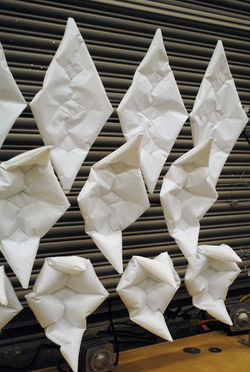NEWmatics: Pneumatically Actuated Inflatables for Responsive and Dynamic Architecture
Graduate Master's Thesis: 2018-19
 newmatics_part2_fully inflatedWhen each row is fully inflated, the screen becomes porous. |  newmatics_part2_actuatedActuated inflatable system arranged to create kinetic screen. |  newmatics_part2_systemThe inflatable units are attached to lightweight cables with a secondary tubing system providing air to each unit. |
|---|---|---|
 newmatics_part2_angledPerspective view of a stop-motion video showing the actuation of each row as air is turned on. |  newmatics_part2_frontFront view stop-motion video of the system inflating row by row. |  newmatics_part1_pushing air event'Raindrop', a large-scale inflatable created collaboratively and put on display at CMU's 'Pushing Air' event |
 newmatics_part1_entryMade in a team of three, 'Raindrop' was a triple-skinned inflatable that aimed to give visitors an ambient underwater experience. |  newmatics_part1_responsive lightingDMX lighting was placed in the walls of the inflatable, allowing the surface to change colors based on sound levels during the event. |  newmatics_part1_occupiableThe interior space was large enough to easily fit ten people, if not more. |
 newmatics_part1_interiorEach of the 24 segments that make up the interior were dyed individually using a traditional shibori technique to create a gradient effect. |
NEWmatics reflects on the history of inflatable architecture and explores how computational design and digital fabrication can be used to create complex dynamic structures. This thesis looks at both traditional and emerging techniques, drawing inspiration from fields such as garment patterning and soft robotics. The work is broken up into two distinct parts. Part one acts as a case study in better understanding the nuances of inflatable architecture: construction, constraints, and material behavior are the three main areas of focus. The result of this research is a 16 foot tall occupiable inflatable built collaboratively within a team of three for a concert held at Carnegie Mellon University. Part two expounds upon material behavior and looks at ways in which inflatables can be used in both deflated and inflated states. The transformative properties of the inflatables in part two can begin to bridge the gap between soft robotics and kinetic architecture. By exploring actuation through patterns embedded into the material itself, adaptive surfaces can be integrated into the built environment that require less maintenance and retain a longer lifespan.
This work was supported in part by funding from the Carnegie Mellon University
Frank-Ratchye Fund for Art @ the Frontier


















